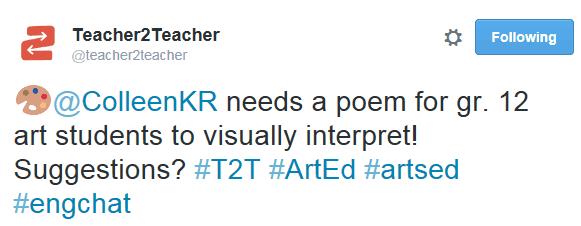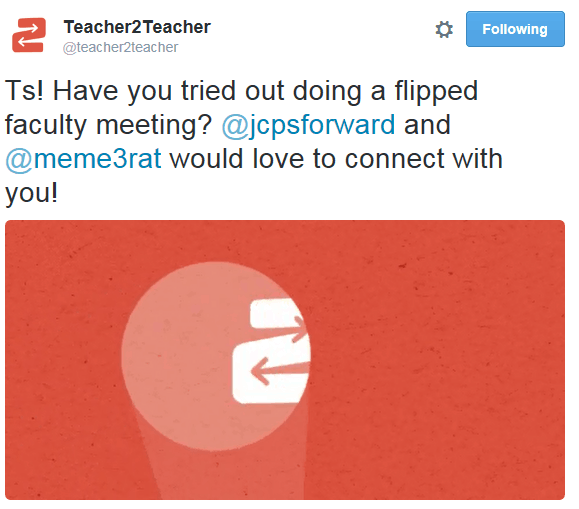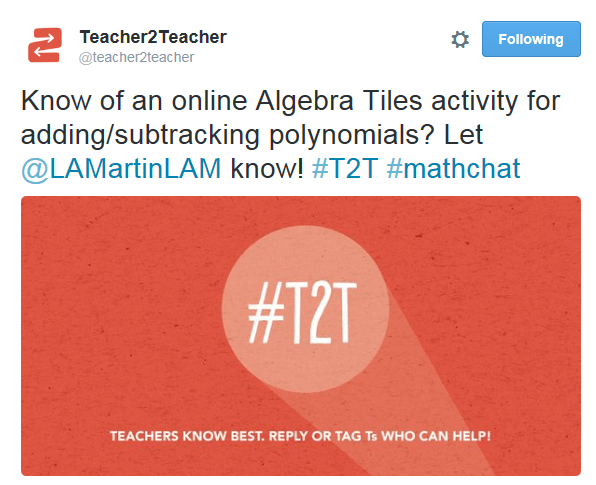7 Ways Teachers Are Connecting and Collaborating Online

By Carina Wong
In a recent survey by the Center for Education Policy, nearly all teachers agreed that collaboration is generally a good use of their time.
To get that valuable time and space to collaborate with fellow educators—in their city, state, country or across the world—some teachers are taking to online networks and DIY-ing their own face-to-face meet-ups. Through grassroots “unconferences” like Edcamps, online forums like #edchat and informal Facebook groups, teachers are taking professional learning into their own hands.
Seeing the rise of these organic, teacher-created modes of professional development, the K-12 Education team at the Bill & Melinda Gates Foundation wondered:
- What if it became standard practice for all new teachers to enter the profession with a professional learning network beyond their school to support their instructional and emotional needs?
- Could an interactive, online teacher-to-teacher network be more effective at spreading good practices and effective teaching tools than traditional “sit and get” professional development models?
- Would teachers in a teacher-to-teacher community be more motivated or feel more equipped to take on new leadership challenges and create positive change in their schools and districts—not just in their own classrooms?
These questions led the foundation to support the development of Teacher2Teacher, a free platform-agnostic, teacher-centered community aimed at building bridges across the teaching profession. Just one year after launching, the community includes—and is driven by—more than 700,000 teachers who give each other inspiration and share ways to improve their practice. Currently, teachers connect to the community through Twitter, Facebook and Instagram, and in the future it may expand to other platforms, such as Pinterest and LinkedIn.
In its first year, this community showed just how powerful social media can be in supporting a community that craves collaboration and connection. Here are seven ways teachers are using it to transform their practice and profession:
- Teacher-leaders are raising their profiles. After a post by teacher Michael Dunlea—who serves as a fellow and leader in several national teacher voice groups—was shared on the Teacher2Teacher Facebook page, his blog received over 12,000 views in two days. He has also had requests for lesson plans and attracted new subscribers to his blog. Teachers emailed him to thank him for sharing his ideas and inspiring them to improve their classroom culture and practice.
- Teachers are expanding their professional networks. An art teacher named Colleen used the @teacher2teacher Twitter account (below) to ask for help integrating literacy into her classroom. She received many responses from teachers around the country, including six English teachers.

- They’re problem-solving collaboratively in real-time. Teachers are making suggestions or posing problems of practice, and other teachers are responding and interacting instantaneously, offering ideas and questions on how to implement similar changes in their classrooms.

- They’re making their needs known. One teacher sent out the following tweet:

This question generated several retweets, which suggests that many teachers are looking for similar resources but don’t know where to find them.
- They’re becoming inspired and equipped to change their practice. Laura Dixon, a Washington, D.C.-area design engineering and technology teacher, attended a series of in-person events we piloted last year called “Engaged Exchanges.” Through this experience, she connected with industry experts and met other teachers in DC with similar interests. She immediately implemented changes in her classroom and is now leading her school in applying design thinking to professional development.
- They’re taking on leadership roles. At a teacher-led conference called Elevating and Celebrating Effective Teachers and Teaching (ECET2), teacher Jamie Ponce attended a special session sponsored by Teacher2Teacher to help her develop her own voice through blogging. She went on to join the National Blogging Collaborative, a teacher network focused on helping other teachers learn how to blog, and is now mentoring other teachers.
- They’re bonding and sharing stories. Last year, Teacher2Teacher launched the #WhyITeach hashtag to encourage teachers to share their stories of purpose. During last year’s Teacher Appreciation Week, we saw 1,400 stories. This year, during the same week, teachers posted 26,500 #WhyITeach messages. All were incredibly moving testimonials about why teachers do what they do.
Of course, social media alone won’t transform teaching. But we are banking on the hypothesis that connecting teachers to other teachers is an overarching benefit that builds every teacher’s professional and social capital. As Andy Smarick, a senior policy fellow at the Thomas B. Fordham Institute, wrote, “When people are connected, they (and even those outside the network) gain, thanks to sharing, interdependence, joint learning, collective action, solidarity, and more.”
Social media is giving teachers a new way to imagine what’s possible. Now the only question is how far that imagination will go and what impact it will have on increasing student success.
For more, see:
- Seeing is More Than Believing in Teacher PD
- Preparing Teachers for 21st-Century Learning
- Literacy Design Collaborative Boosts Student and Teacher Learning
Carina Wong is Deputy Director at The Bill & Melinda Gates Foundation. Follow her on Twitter: @CarinaWong1.
Stay in-the-know with all things EdTech and innovations in learning by signing up to receive the weekly Smart Update.







Daniel Adebayo
I believed teachers are "co-destiny builder "with God!
Teachers can solve big problems in our society, including UNEMPLOYMENT CRISIS. By promoting entrepreneurship oriented education in their day-to-day teaching practices.
I love teachers,
I want to marry a professional teacher/administrator